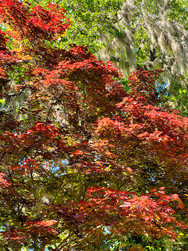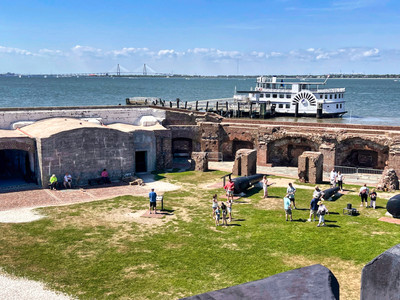
Our 2022 RV travels began with a southern swing through Virginia and the Carolinas. We wanted to begin this year’s trip with some relaxation, so camping beside a lake seemed like the ticket. You may remember that last fall we camped at two Army Corps of Engineers (CoE) lakes on our trip east from Colorado. Leaving home on April 12, we traveled to another CoE lake, the John H. Kerr Reservoir on the border of Virginia and North Carolina. Created in 1956, the reservoir dams part of the Roanoke River.
It's always a bit of a crapshoot trying to find campsites on a map. Who could tell when we reserved site 152 from this map…

…we would end up with such a gorgeous lakeside view?

Much of our time we spent chilling and admiring the scenery. We also had a chance to try out our new Lectric XP 2.0 eBikes which we’d purchased over the winter.

They fold for travel, so we can store one in the RV and one in a rolling tub in the back of the Fittata. The pedal assist from the lithium-ion battery is helpful on the uphills and allows us to ride for 5-10 miles or longer without feeling fatigued by the end of the trip.
We also hiked the Liberty Hill Nature trail which is just downriver from the Kerr Dam. After winter’s bleakness, it was so nice to see the green of new spring growth.

Moving on from the reservoir, we traveled south to Wilmington, North Carolina, our first time there since we’d visited 20+ years ago with our kids. We explored the beach communities in Wrightsville Beach (crowded) and Topsail Island (not crowded) and sampled the local seafood.
One day we explored Airlie Gardens, which showcases southern trees and plants, including a magnificent 400-year-old live oak complete with hanging Spanish moss.

There are also many blooming camelias.
A section of the garden is devoted to Minnie Evans, an African-American artist who’d served as a groundskeeper there for 25 years. It includes a house made from glass bottles.
There is also a lovely pergola garden on a lake, featuring fountains and sculptures.
The morning we left Wilmington we stopped by the USS North Carolina memorial. The World War II-era battleship is open daily for tours both above and below decks. It was the mainstay of each of our family trips to the area in days gone by. We had a very interesting tour through the ship, without the worry and constant searching for boys who might be getting into the wrong places.

We continued south to Myrtle Beach, South Carolina. We’d camped there with our sons a couple of decades ago but had not been back since. If you’ve been to Myrtle Beach, you’ll know it’s a place of golf courses (not our thing), amusement parks and attractions, and beaches lined with tall condos on the northside...

...and mega campgrounds (three of which have almost 4,000 sites between them) on the southside.

We stayed in Myrtle Beach State Park, a forested oasis amidst the sprawl with almost a mile of sandy beach.

They even have a public fishing pier which one can walk on to without going through a gift shop or paying a fee.


Unfortunately, the weather was too cool and windy for sunbathing...


...but we had some nice hikes through the park forests and along the beach.
We came upon a ranger program where they were having the kids pretend to be nesting sea turtles.

While in the area, we drove about a half-hour south to Brookgreen Gardens, assembled from four old plantations and now a showcase of both plants and sculpture.

From Myrtle Beach we continued south to Charleston, South Carolina, a new destination for us. During our three-day visit we sampled some of the local cuisine (BBQ and seafood)…

…took a walking tour through the historic sections of town…

…and took a boat ride out to Fort Sumter, site of the first battle of the Civil War, which sits at the mouth of the Charleston harbor.
We also visited McLeod Plantation. Operated by Charleston County, it focuses visitors' attention mostly on the slave experience, rather than that of the plantation owners (the focus of most other plantation tours in the area). They did not shy from describing the oppression and brutality, and talked about tracing the descendants of some of the slaves from the end of the Civil War until modern day. As late as 1990, some descendants of former plantation slaves lived in the slave houses as share croppers. One evening in 1990, an evening messenger told them they had 24 hours to pack up all their belongings. The new owners of the plantation, the Charleston Historical Society, wanted them out.


The guides also described how the Gullah culture (a mix of Caribbean and West African language and traditions) had been maintained on these fairly isolated barrier islands not the South Carolina coast.


We turned inland and spent a couple of days at little-known Congaree National Park near the South Carolina state capital of Columbia. A small park by national park standards, It’s a place of old growth hardwood forest and low country swamps.
Unfortunately, recent rainstorms had left many of the park trails flooded and underwater (a common occurrence, according to the NPS).

Besides restricting hiking, the flooding also meant that we were not able to do a planned paddle in our kayak through the heart of the park.
Fortunately, we were able to hike about 2/3 of the 2.8-mile-long and elevated Boardwalk Trail that starts near the visitor center.

One interesting phenomenon of the flooding was that it was sometimes difficult to tell what was reality and what was reflection.


In some places, flood waters flowed slowly through the trees.

In other places, areas of the forest recently cleared through a controlled burn...

...contrasted with others carpeted with delicate yellow Butterweed flowers.

Thus ended the "southern swing" portion of our RV adventures. We returned home for about three days, and then embarked on the main event - a trip northward along the Atlantic coast and into Canada. More about that in our next blog post!













































































Comments